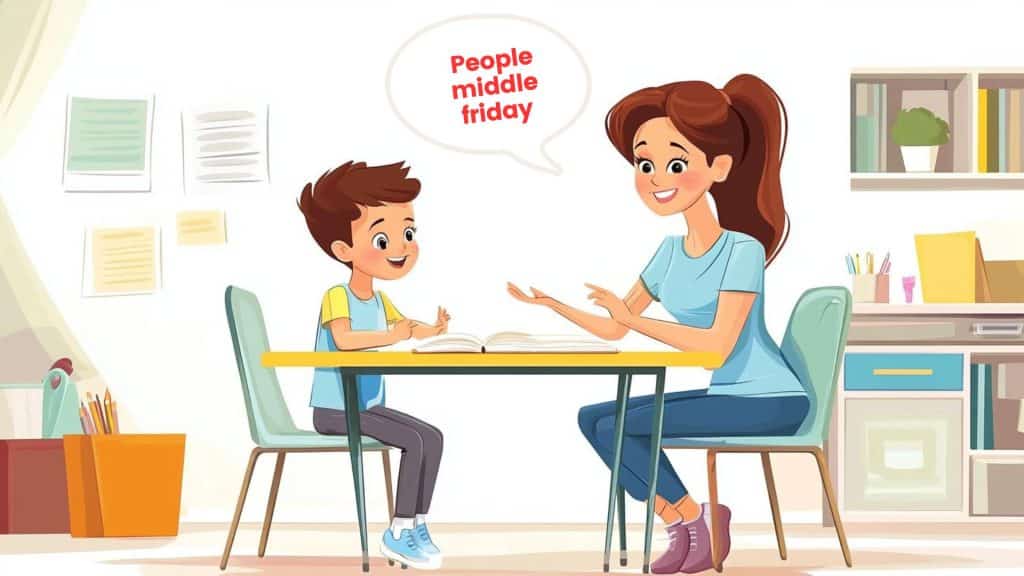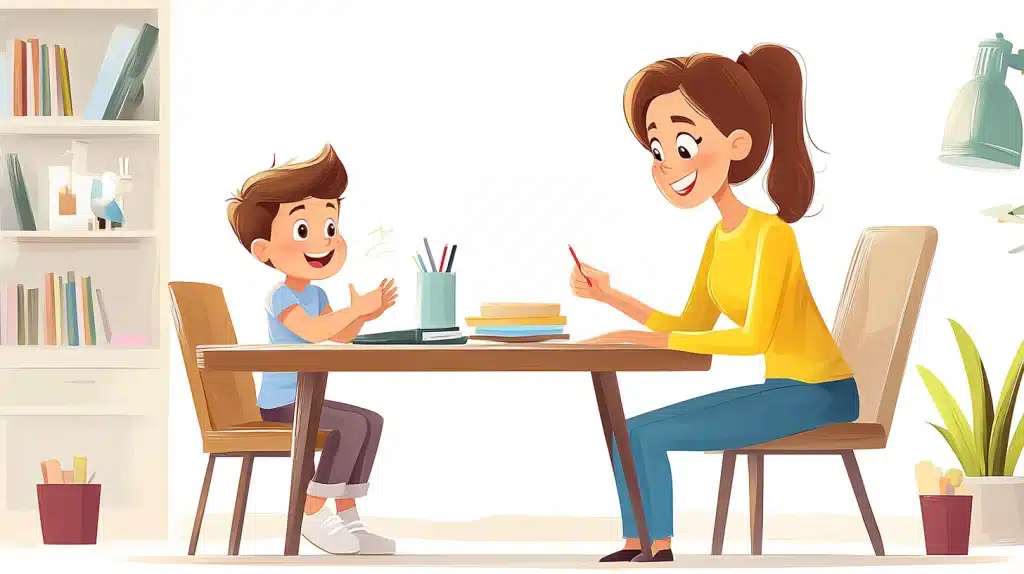Two-syllable words play a crucial role in speech therapy and language development.
These words help children develop essential speech and language skills but can also pose challenges for those with speech sound disorders.
Understanding the importance of two-syllable words and implementing effective teaching strategies can significantly improve a child’s speech and language abilities.
In this article, we will explore the role of two-syllable words in speech therapy and discuss common difficulties children may face.
We will also provide practical techniques and activities speech-language pathologists can use to help children master these words and enhance their overall language development.
Importance of Two-Syllable Words in Speech Therapy

Two-syllable words are essential in speech therapy for several reasons:
- They help improve speech clarity, making it easier for others to understand the child.
- These words provide a basis for the natural flow, beat, and tone of speech.
- Learning two-syllable words expands a child’s vocabulary, allowing them to express themselves better.
- Mastering these words sets the stage for future reading and writing success.
Two-syllable words are the building blocks of language development, bridging the gap between simple, single-syllable words and more complex, multi-syllable words.
As children progress in their speech and language journey, two-syllable words are crucial for mastering longer and more intricate words.
Moreover, two-syllable words often represent common objects, actions, and concepts children encounter daily.
Focusing on these words in speech therapy can help children learn to communicate more effectively about their everyday experiences, fostering better social interactions and overall language comprehension.
Incorporating two-syllable words into speech therapy sessions also allows therapists to target specific speech sounds and patterns that may be challenging for children.
By practicing these words in a structured, supportive environment, children can develop motor planning skills and muscle memory to produce these sounds accurately and consistently.
Enhances Speech Intelligibility
When children can correctly pronounce two-syllable words, their speech becomes clearer and more understandable to those around them.
This boost in clarity helps build their confidence and encourages them to communicate more freely with others.
Improved speech intelligibility has far-reaching effects on a child’s overall development:
- When a child’s speech is easier to understand, they are more likely to engage in conversations with peers and adults, leading to better social interactions and relationships.
- Clear speech also reduces frustration for the child and their listeners, as the child can effectively convey their thoughts, needs, and emotions.
In addition, enhanced speech intelligibility can positively impact a child’s academic performance:
- When children can articulate words clearly, they are better equipped to participate in classroom discussions, ask questions, and demonstrate their knowledge.
- This increased confidence and communication ability can improve learning outcomes and overall academic success.
Speech therapists are crucial in helping children achieve better speech intelligibility through targeted exercises and activities focused on two-syllable words:
By breaking down these words into smaller, more manageable components and providing consistent feedback and support, therapists can guide children toward clearer, more accurate speech production.
Challenges with Two-Syllable Words
Some children may struggle with two-syllable words due to various speech and language disorders:
1. Phonological Disorders
Children with phonological disorders may have difficulty with syllable deletion, such as saying “nana” instead of “banana” or “batty” instead of “battery.”
This occurs when a child omits a syllable or a weak syllable within a word.
Phonological disorders can significantly impact a child’s ability to communicate effectively:
- The omission or alteration of syllables can change the meaning of words or make them unrecognizable to listeners.
- These disorders may stem from underlying difficulties in processing and organizing speech sounds, leading to patterns of errors in speech production.
Speech therapists can help children with phonological disorders by targeting specific error patterns and providing structured activities to practice correct syllable production:
- This may involve using visual aids, such as pictures or objects, to help children associate words with their correct pronunciations.
- Therapists may also use auditory bombardment techniques, where the child is repeatedly exposed to the correct pronunciation of a word to help them internalize the proper sound patterns.
In addition to direct speech therapy interventions, parents and caregivers can support children with phonological disorders:
- Providing consistent, positive reinforcement for correct pronunciations and modeling accurate speech patterns in everyday interactions.
- Creating a supportive, language-rich environment at home can complement the work done in speech therapy sessions and accelerate a child’s progress in overcoming syllable deletion challenges.
2. Articulation Disorders
Articulation disorders can cause children to frequently substitute, add, omit, or distort sounds when attempting to say two-syllable words. These errors can make their speech harder to understand.
Articulation disorders can range from mild to severe. Some children struggle to produce specific speech sounds, while others may struggle with a wide range of sounds.
These disorders can be caused by various factors, including:
- Structural abnormalities in the mouth or throat
- Neurological conditions
- Developmental delays
When working with children with articulation disorders, speech therapists focus on helping them develop the necessary motor skills and coordination to produce speech sounds accurately:
- This may involve exercises to strengthen the muscles used in speech production, such as the lips, tongue, and jaw.
- Therapists may also use tactile feedback, such as placing a tongue depressor or other tool in the child’s mouth, to help them feel the correct placement of their articulators when producing specific sounds.
- Visual aids, such as mirrors or diagrams of the mouth, can also help teach children with articulation disorders how to position their articulators correctly.
- Therapists can guide children toward more accurate sound production in two-syllable words and beyond by providing clear, step-by-step instructions and demonstrations.
Consistency and repetition are key in addressing articulation disorders:
- Therapists often assign home practice activities to reinforce the skills learned in therapy sessions.
- Parents and caregivers can support their child’s progress by regularly engaging in these activities and providing positive feedback and encouragement.
Effective Strategies for Speech Therapists
Speech therapists can use several techniques to help children master two-syllable words:
1. Backward Chaining
This method involves starting with the last syllable of a word and gradually working backward.
For example, when teaching the word “butterfly,” the therapist begins with “fly” and then progresses to “terfly” and finally “butterfly.”
Backward chaining is an effective strategy for teaching two-syllable words because it allows children to build upon their successes and gradually increase the complexity of the word they are learning.
- Children can anchor their pronunciation and add the preceding syllables one at a time by starting with the last syllable, which often carries the most distinctive sound or stress pattern.
- This approach can be particularly helpful for children who struggle with motor planning or sequencing, as it breaks the word down into smaller, more manageable units. As the child masters each syllable, they gain confidence and develop the necessary motor patterns to produce the complete word accurately.
To implement backward chaining effectively, speech therapists should:
- Select meaningful and relevant words that fit the child’s interests and experiences. They can use visual aids, such as pictures or objects, to help the child associate the word with its meaning and provide a concrete reference point for pronunciation.
- Provide clear, concise instructions and model the correct pronunciation of each syllable before asking the child to attempt it themselves.
- Offer consistent feedback and positive reinforcement to help the child stay motivated and engaged throughout the learning process.
As the child becomes more proficient with backward chaining:
- The therapist can gradually increase the complexity of the words targeted and begin to fade the support provided, encouraging the child to produce the complete word independently.
- With repeated practice and success, children can develop the skills and confidence needed to tackle a wide range of two-syllable words using this strategy.
2. Forward Chaining
Forward chaining is the opposite of backward chaining, where the therapist starts with the first syllable and moves forward.
Using the same example, the therapist would begin with “buh,” then move on to “butter,” and finally “butterfly.”
Forward chaining can be an effective strategy for teaching two-syllable words, particularly for children with difficulty with the initial sounds or syllables of words.
- By starting with the first syllable and gradually building upon it, children can develop a strong foundation for the word and then add the subsequent syllables logically and sequentially.
- This approach can be especially helpful for children with articulation disorders or difficulties with specific speech sounds, as it allows them to focus on one sound or syllable at a time and master it before moving on to the next.
- As the child becomes more comfortable with each syllable, they can blend them to form the complete word.
To use forward chaining effectively, speech therapists should:
- Choose developmentally appropriate words relevant to the child’s needs and interests.
- Use multi-sensory approaches, such as pairing the word with a gesture or movement, to help the child associate the word with its meaning and develop a kinesthetic memory for its pronunciation.
- Provide ample opportunities for the child to practice each syllable and the complete word in various contexts, such as in isolation, short phrases, and full sentences.
- Offer consistent feedback and positive reinforcement to help the child maintain motivation and build confidence as they progress through the chaining sequence.
As the child becomes more proficient with forward chaining:
- The therapist can begin to target more complex two-syllable words and gradually reduce the level of support provided, encouraging the child to produce the word independently.
- With repeated practice and success, children can develop the skills and strategies needed to tackle a wide range of two-syllable words using this approach.
Activities to Reinforce Learning of Two Syllable Words
1. Reading Books
Choose books featuring multisyllabic words, like “Dragons Love Tacos,” to engage children and provide practice opportunities.
Reading books with two-syllable words reinforces skills learned in speech therapy:
- Select stories with relevant two-syllable words
- Emphasize target words through pronunciation and gestures
- Encourage child participation
These books help develop overall language skills:
- Vocabulary
- Comprehension
- Narrative abilities
Children engage with the story to:
- Understand word usage in context
- Appreciate meaning and usage
Extend learning beyond reading:
- Create follow-up activities (e.g., word searches, coloring pages, games)
- Generalize and apply skills in new contexts
Incorporating such books into routines creates a language-rich environment, supporting speech and language development.
Exposure to diverse words and stories builds a strong literacy foundation and a love for reading.
2. Puzzle Pieces
Use puzzles to teach syllables entertainingly by assigning each syllable to a puzzle piece for the child to assemble.
Puzzle pieces make learning two-syllable words fun and interactive, helping children develop phonological awareness and motor planning skills.
Creating a syllable puzzle:
- Write each syllable on a separate puzzle piece, including a picture of the word
- Use large, durable pieces suitable for the child’s handling
During practice sessions:
- Present the puzzle pieces and have the child assemble the word
- Encourage the child to say each syllable aloud and blend them
- Provide prompts and feedback for error correction and success reinforcement
Adapt puzzles to various skill levels and learning styles:
- Provide word models and guide the child’s hand for beginners
- Gradually reduce support as the child becomes more proficient
Syllable puzzles help children develop the following:
- Problem-solving skills
- Fine motor coordination
Create games and challenges:
- Time the child’s word assembly speed
- Race against a partner to complete the puzzle
Incorporating syllable puzzles into therapy sessions and home practice provides a fun, engaging way to learn and practice two-syllable words.
As children become more proficient, they develop a strong foundation for reading and spelling, benefiting their academic and personal lives.
3. Games and Play
Incorporate fun activities like drumming out syllables, coloring worksheets, and creating silly sentences with two-syllable words to keep children engaged and motivated.
Games and play-based activities are essential for children’s speech therapy, as they provide a fun, engaging way to practice and reinforce new skills.
Therapists and parents can incorporate various games and activities to keep children motivated and engaged in the learning process when working on two-syllable words.
One simple activity is drumming out syllables:
- The child taps a drum or claps their hands for each syllable in a word.
- This activity helps children develop their phonological awareness and motor planning skills by breaking the word into its parts and producing each syllable in sequence.
- The adult can provide a model of the word and then have the child repeat it, gradually fading their support as the child becomes more proficient.
Creating silly sentences with two-syllable words can be a fun and creative way to practice using these words in context:
- The adult can provide a list of target words and have the child use them to create a silly or nonsensical sentence, such as “The purple monkey ate a cookie on the moon.”
- This activity can help children develop their expressive language skills and creativity while reinforcing their mastery of two-syllable words.
Other games and activities that can be used to practice two-syllable words include:
- Memory games where the child matches pictures of objects with their corresponding words
- Bingo games where the child marks off words on a card as they are called out
- Scavenger hunts where the child searches for objects in their environment that have two-syllable names
- Rhyming games where the child generates words that rhyme with a given two-syllable word
By incorporating a variety of games and play-based activities into their therapy sessions and home practice routines, therapists and parents can help children develop their skills with two-syllable words in a fun, engaging way.
As children become more proficient with these activities, they can develop a strong foundation for language and literacy that will serve them well throughout their lives.
Conclusion
In conclusion, two-syllable words are the foundation of language development and play a crucial role in speech therapy.
Therapists and parents can help children master these words by using targeted strategies and engaging activities, enhancing their speech clarity, phonological awareness, vocabulary, and social communication skills.
The impact of this work extends far beyond the therapy room, setting children up for success in reading, writing, and building connections with others.
Early intervention and consistent practice are key to unlocking a child’s full communicative potential.
By prioritizing the mastery of two-syllable words and working together, therapists and families can help children develop the strong language skills they need to thrive in all aspects of their lives, paving the way for a bright future filled with effective communication and meaningful relationships.









